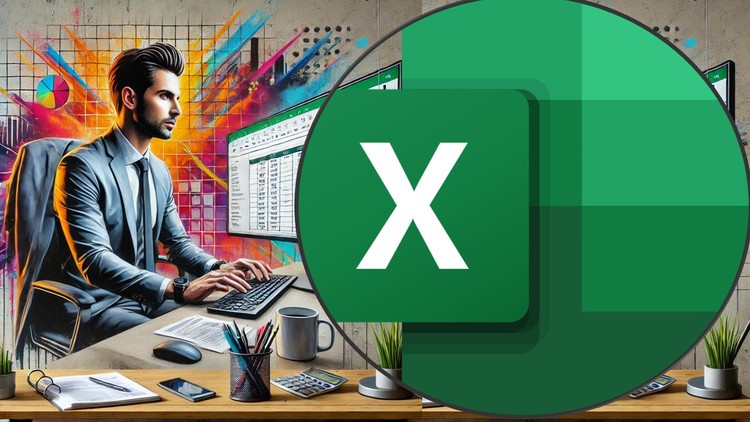
Excel for Accountants: Subledgers, Financial Statements, and Tax Transactions Made Simple
⏱️ Length: 9.3 total hours
⭐ 4.63/5 rating
👥 3,299 students
🔄 February 2025 update
Add-On Information:
Note➛ Make sure your 𝐔𝐝𝐞𝐦𝐲 cart has only this course you're going to enroll it now, Remove all other courses from the 𝐔𝐝𝐞𝐦𝐲 cart before Enrolling!
- Course Overview
- This course dives deep into the practical application of accounting principles, specifically focusing on translating fundamental financial concepts into actionable Excel-driven processes.
- You’ll move beyond theoretical understanding to hands-on data manipulation, simulating the day-to-day financial operations of a business during its crucial initial months.
- The curriculum emphasizes building a robust and accurate financial record-keeping system using Excel, designed to streamline complex accounting tasks.
- It bridges the gap between the foundational accounting equation and the sophisticated reporting and analysis required in a real-world business environment.
- The course is structured to guide you through the accumulation and refinement of financial data, culminating in the generation of key financial reports.
- You will gain proficiency in managing intricate transactional data, ensuring its integrity and compliance with accounting standards.
- The February 2025 update signifies a commitment to current software versions and relevant accounting practices.
- With a significant 9.3 total hours of content and a high student rating, this course offers comprehensive learning and practical skill development.
- The extensive student base of 3,299 indicates a high demand for the skills taught and positive learning experiences.
- Requirements / Prerequisites
- A foundational understanding of basic accounting principles, including the concept of the accounting equation (Assets = Liabilities + Equity).
- Familiarity with the Windows operating system or macOS.
- Access to a functional version of Microsoft Excel (specific versions may be recommended but not strictly required as long as core functionality is present).
- A willingness to learn and apply Excel functions and features to accounting scenarios.
- Basic computer literacy, including the ability to navigate software and manage files.
- No prior advanced Excel knowledge is assumed, but a comfort level with basic spreadsheet operations is beneficial.
- Skills Covered / Tools Used
- Advanced Excel Functions: Mastery of lookup functions (VLOOKUP, XLOOKUP), logical functions (IF, AND, OR), and financial functions for data analysis and automation.
- Data Validation and Integrity: Techniques for ensuring accuracy and preventing errors in financial data entry.
- Subledger Management: Practical implementation of detailed records for specific accounts to facilitate granular tracking.
- Financial Statement Preparation: Building and interpreting the Balance Sheet and Income Statement from raw transactional data.
- Payroll and Tax Calculations: Understanding and executing calculations for employee wages, deductions, and associated tax liabilities.
- Sales Tax Processing: Accurate recording, calculation, and reporting of sales tax transactions.
- Reconciliation Techniques: Employing Excel to match and verify financial records against external sources.
- Process Automation: Designing Excel models to automate recurring accounting tasks, saving time and reducing manual effort.
- Microsoft Excel: The primary software tool used throughout the course for all data input, manipulation, and reporting.
- Benefits / Outcomes
- Enhanced Data Accuracy: Develop a keen eye for detail, ensuring the integrity and reliability of financial information.
- Improved Efficiency: Significantly reduce the time spent on repetitive accounting tasks through automation and smart Excel usage.
- Deeper Understanding of Financial Flows: Gain a practical, hands-on comprehension of how financial transactions impact the accounting equation and financial statements.
- Career Advancement: Acquire in-demand skills that make you a more valuable asset in accounting and finance roles.
- Confidence in Financial Reporting: Be able to confidently prepare and interpret essential financial statements.
- Compliance Assurance: Understand and execute procedures for accurate tax calculations and timely payments.
- Strategic Financial Analysis: Move beyond data entry to the analysis of financial performance, enabling better business decision-making.
- Modern Accounting Practices: Align your skills with contemporary accounting software and methodologies.
- PROS
- Practical, Hands-On Approach: Focuses on immediate application of concepts in Excel, fostering real-world readiness.
- Comprehensive Coverage of Key Accounting Tasks: Addresses fundamental areas like subledgers, statements, and tax, crucial for entry-level to intermediate accountants.
- Emphasis on Efficiency Through Excel: Teaches how to leverage Excel to automate and streamline common accounting workflows.
- Strong User Ratings and Recent Update: Indicates a well-received course that is kept current with relevant practices.
- CONS
- Limited Scope for Advanced Accounting Theory: Primarily focused on the mechanics of data input and reporting within Excel, rather than abstract theoretical accounting principles.
Learning Tracks: English,Finance & Accounting,Accounting & Bookkeeping
Found It Free? Share It Fast!